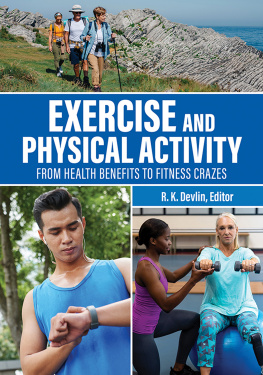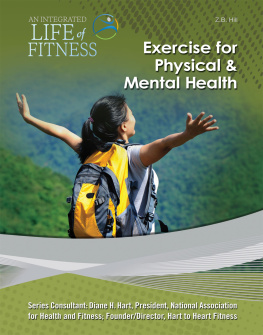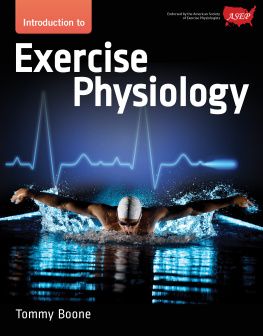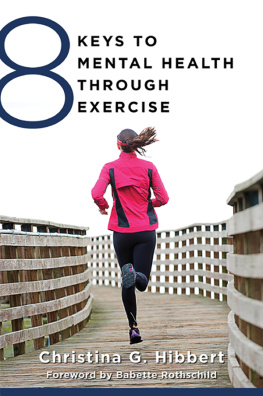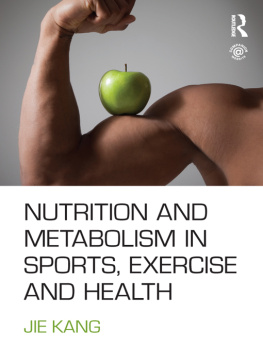Exercise and Physical Activity
Exercise and
Physical Activity
From Health Benefits to Fitness Crazes
R. K. Devlin, Editor

Copyright 2022 by ABC-CLIO, LLC
All rights reserved. No part of this publication may be reproduced, stored in a retrieval system, or transmitted, in any form or by any means, electronic, mechanical, photocopying, recording, or otherwise, except for the inclusion of brief quotations in a review, without prior permission in writing from the publisher.
Library of Congress Cataloging-in-Publication Data
Names: Devlin, R. K., editor.
Title: Exercise and physical activity : from health benefits to fitness crazes / R.K. Devlin.
Description: Santa Barbara, California : Greenwood, 2022. | Includes bibliographical references and index.
Identifiers: LCCN 2022014955 | ISBN 9781440878435 (hardcover) | ISBN 9781440878442 (ebook)
Subjects: LCSH: Exercise.
Classification: LCC RA781 .E8918 2022 | DDC 613.7/1dc23/eng/20220606
LC record available at https://lccn.loc.gov/2022014955
ISBN: 978-1-4408-7843-5 (print)
978-1-4408-7844-2 (ebook)
26 25 24 23 22 1 2 3 4 5
This book is also available as an eBook.
Greenwood
An Imprint of ABC-CLIO, LLC
ABC-CLIO, LLC
147 Castilian Drive
Santa Barbara, California 93117
www.abc-clio.com
This book is printed on acid-free paper 
Manufactured in the United States of America
Contents
ANATOMY
BASIC SCIENCE AND CONCEPTS
PRACTICAL APPLICATIONS
HEALTH BENEFITS AND RISKS
EXERCISE AND SOCIETY
Exerciseyou have read about the latest trends in magazines and books, you have studied some of the related anatomical and physiological processes in school, you have watched people competitively engaged in it on television or online, you have probably downloaded an app for it, and at some point, you have done it yourself. It may seem like you are already inundated with daily results from athletic events, information about new workouts and training tips, and reviews of exercise equipment and footwear. What, then, can a book like Exercise and Physical Activity: From Health Benefits to Fitness Crazes offer you?
Despite the presence of exercise on our screens or on the page, the simple truth is that most of us simply do not do enough of it. According to the Centers for Disease Control and Prevention (CDC), recent data suggests that one in five high school students in the United States do not meet recommended physical activity guidelines, and at least 25 percent of American adults do no physical activity outside of their regular job. With little or no participation in exercise, millions of us are putting our health at risk for heart disease, high blood pressure, stroke, diabetes, certain types of cancer, low bone density, and obesity. We are also more stressed, struggling with depression and anxiety, burdened by poor sleep, and chronically fatigued. These problems, all influenced by inactivity, are associated with an estimated $117 billion annually in health-care costs.
Engaging in physical activity is one of the best things you can do for your health, and there are many individuals, public health programs, organizations, and businesses dedicated to helping you become more active. How do you figure out what physical inactivity does to your body? Where can you explore the various activities and sports you might be interested in trying? Which muscles are involved in exercise, and how do you decide on the exercises that will make them stronger? What benefits come with exercise, and what related injuries can you prevent? What career options focus on health, fitness, and exercise? What organizations offer further resources on health, fitness, and exercise if you need them? Exercise and Physical Activity: From Health Benefits to Fitness Crazes answers these questions and more.
As an adolescent, I was very much drawn to sports, and I competed in cross-country, volleyball, and track (I dabbled a bit in swimming and cross-country skiing, too). I loved training and sometimes snuck in extra workouts before school. I loved the comradery among my teammates and the work we did together to win. And I loved setting a competitive goal for myself and achieving it. Though I only participated in intramural sports at university, I was lucky to land a job at the Olympic Education Center on my college campus in Northern Michigan while majoring in exercise physiology. After graduation, I moved to Colorado to complete a masters degree in biomechanics while continuing work at the Olympic Training Center in Colorado Springs. For my thesis, I worked with the best swimmers in the country as I studied how to minimize the coefficients of lift and drag force in the water. Though I eventually chose to go to medical school rather than pursuing a PhD, I still love how sports, exercise science, kinesiology, and psychology come together as athletes strive to perform at their best.
When the chance to edit Exercise and Physical Activity: From Health Benefits to Fitness Crazes was offered, I said yes without hesitation; it was a great way to revisit the beauty of our muscular anatomy, to review and update the scientific concepts I had enjoyed studying in the past, to explore new sports and activities that I have never participated in, to consider the injuries related to activity and how to minimize the risk of occurrence, and to celebrate the past and present heroes that have influenced the American evolution of health and fitness. This book is designed to provide you with concise but necessary information about exercise and physical activity, all within one easy-to-read resource. Exercise and Physical Activity: From Health Benefits to Fitness Crazes includes over 200 entries that cover five main themes: Anatomy, Basic Science and Concepts, Practical Applications, Health Benefits and Risks, and Exercise and Society.
Did you know there are an estimated 650 named skeletal muscles in the body? Under the Anatomy theme, you will find entries on all the major skeletal muscle groups of the human body, from the neck to the ankles and feet. You will learn the names of muscles, their origins and attachment points, and how they move the human body. Tips on specific muscle-strengthening exercises and risks of potential injury are included as well. Entries on the connective tissues that attach muscles to bones, stabilize joints, prevent muscle friction, and aid in movement are also found in the Anatomy category.
The entries found under the theme of Basic Science and Concepts cover topics within the advancing fields of exercise physiology, kinesiology, exercise science, and sports psychology. You will learn how alcohol, caffeine, nutrition, and pregnancy influence exercise and performance. The concepts of anabolism and catabolism, aerobic and anaerobic exercise, maximal oxygen uptake, and hydration and dehydration will be explained. You will even be taught how to measure body mass index (BMI), along with other ways to assess your fitness level through testing.
Within the Practical Applications theme, entries have been provided on seventy-two diverse sports and physical activities, including aerial arts, disc golf, ice hockey, kickboxing, rock climbing, and many more. Each entry provides you with a description of the activity, its history (particularly within the United States), and the physical and psychological health enhancements and injuries that can be associated with participation.

